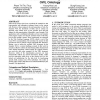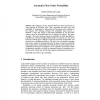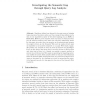DEXAW
2008
IEEE
13 years 11 months ago
2008
IEEE
The semantic web aims at enabling the web to understand and answer the requests from people and machines. It relies on several standards for representing and reasoning about web c...
FOIKS
2010
Springer
13 years 12 months ago
2010
Springer
As a vision for the future of the Web, the Semantic Web is an open, constantly changing and collaborative environment. Hence it is reasonable to expect that knowledge sources in th...
INTERACTION
2009
ACM
13 years 12 months ago
2009
ACM
DTD and its instance have been considered the standard for data representation and information exchange format on the current web. However, when coming to the next generation of w...
SEMWEB
2009
Springer
13 years 12 months ago
2009
Springer
Abstract. Most Semantic Web applications are build on top of technology based on the Semantic Web layer cake and the W3C ontology languages RDF(S) and OWL. However RDF(S) embodies ...
SEMWEB
2009
Springer
13 years 12 months ago
2009
Springer
A key question regarding the future of the semantic web is “how will we acquire structured information to populate the semantic web on a vast scale?” One approach is to enter t...
SEMWEB
2009
Springer
13 years 12 months ago
2009
Springer
This paper outlines the first stage of the ODARyT Tool, a semantic web approach to represent and retrieve information in a corporate memory. After a brief discussion about the mee...
SEMWEB
2009
Springer
13 years 12 months ago
2009
Springer
Most languages for the Semantic Web have their logical basis in some fragment of first-order logic. Thus, integrating first-order logic with probability is fundamental for represen...
SEMWEB
2009
Springer
13 years 12 months ago
2009
Springer
Significant efforts have focused in the past years on bringing large amounts of metadata online and the success of these efforts can be seen by the impressive number of web site...
SEMWEB
2009
Springer
13 years 12 months ago
2009
Springer
Abstract. The Semantic Web fosters novel applications targeting a more efficient and satisfying exploitation of the data available on the web, e.g. faceted browsing of linked open...
SEMWEB
2009
Springer
13 years 12 months ago
2009
Springer
Abstract. The work on integrating sources and services in the Semantic Web assumes that the data is either already represented in RDF or OWL or is available through a Semantic Web ...




